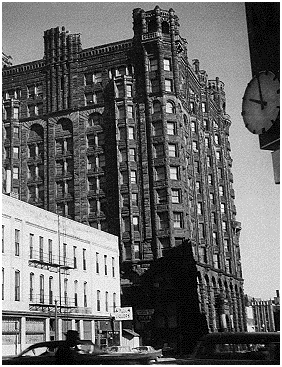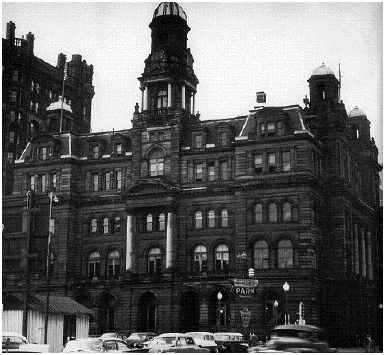The Life and Death
Of Minneapolis's
Skid Row
Joseph Hart
Edwin Hirschoff
Photographer
(Minnesota)

And speaking of community, the final insult was that while we were waiting around for the warheads to descend, there came into being another kind of warhead --- something cooked up by the federal government, the mortgage bankers, the Chambers of Commerce and real estate moguls. They joined forces to destroy the oldest and grandest parts of our cities, operating under the rubric of "Urban Renewal." Unbeknownst to most of us, it was slipped in under the door disguised with the benign- Swag for buying up these older areas of town was provided by the Feds, matched by city and state taxes. The local cash provided for destroying older buildings. The land would then be turned over at less than cost to private developers so they could build banks, retail establishments, office towers, and in general, rob the rest of us of our heritage. Thus we were all given the chance to contribute to the rich so they could get richer. What the planners called "slums" turned out to be homes and mostly viable living areas for the poor. Their apartments --- many grand, older buildings from the turn-of- The Housing Act, originally put together in 1939, had set aside funds and land for low-income housing. But by the time the federal and state and city lobbyists got through with it, only about 10 of the net was to be dedicated to that purpose. Even more ruinous was a codicil introduced in 1955, which stated that any parts of cities near to these "slum" areas could be designated for destruction as well. According to one critic, "In practical terms, this made it possible for a plan to encompass areas that were not run down by claiming they would become slums if they were not part of the redevelopment program." In some cities, fifty to eighty percent of livable downtown areas were destroyed to make way for new edifices of the icy International Style, banks and motels and business offices and government buildings --- none of which contributed to the necessary street life of cities, what Jane Jacobs had called "the eyes of the city." The Russians could not have sent a smart bomb as effective in destroying our cities and their culture.
Thanks to the late Edwin Hirschoff, we have a permanent record of the tearing down of the heart of Minneapolis. Called the Lower Loop, some twenty-five blocks of 19th and early 20th century buildings --- 200 of them in all--- fell to the wrecking ball. It represented more than 40% of downtown Minneapolis. The press of the time called it "an occasion for civic rejoicing." By 1965, most of the area had been turned into parking lots and buildings of pure glass and steel. The poor had to find housing elsewhere. Hirschoff took more than 400 photographs: the buildings before the onslaught, the buildings being destroyed, and the flattened areas after demolition. As the editor of this book recounts, His photos leave the impression of empty streets, abandoned buildings, massive piles of rubble --- and of the strange, contemporary structures constructed upon the ruins. Fifty or so of his photographs are included in this volume, along with earlier shots of life in the Lower Loop before it was ravaged. Too, there is narrative by Joseph Hart which tells of the history of this area: its early days as living and employment center for the poor, the decline into what people liked to call "Skid Row," and the final denouement. What would be there today if the real estate interests had not had their way? Probably Minneapolis would have followed the lead of cities like San Francisco, Portland and Seattle, where many older buildings were rehabilitated and used for restaurants, living --- some of it low income apartments --- and working space. In these downtowns, we get a feel for what it must have been like a century ago when the streets were thronged with life, buildings were of a scale to encourage human interaction, and the lively world of downtown city life was a reality. I was going to reproduce five or six of the photographs in this volume, but after two, as I leafed through the book and I got too weepy to continue. I am easily moved by unnecessary vandalism and destruction of our history which, in my case, was brought to a head by a shot of the now defunct Soo Line Building, with its glorious tower, columns, mansard roof, and arched windows [see Fig 2 above]. The Minneapolis Tribune editorialized at the time: "The ugliness of blight is ... disappearing and a new beauty and orderliness replace it." But a local architect said that it was "the most inexcusable act of civic vandalism in the history of Minneapolis."  You don't have to look far to see the result of these decades of "urban renewal." Perspectives of scale, variety, and architectural interest were all sacrificed. Go to your public library, look at pictures from your downtown area the years before the 1950s and weep. Or, you can see it laid out in photographs of a representative city --- both before and after --- in this new volume, Down and Out: The Life and Death of Minneapolis's Skid Row.
You don't have to look far to see the result of these decades of "urban renewal." Perspectives of scale, variety, and architectural interest were all sacrificed. Go to your public library, look at pictures from your downtown area the years before the 1950s and weep. Or, you can see it laid out in photographs of a representative city --- both before and after --- in this new volume, Down and Out: The Life and Death of Minneapolis's Skid Row.